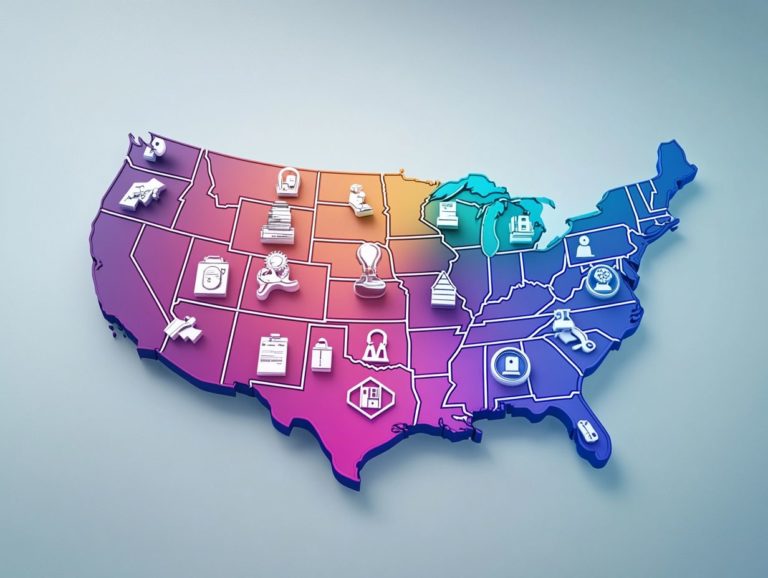What to Expect When Shopping for High-Risk Insurance
Navigating the realm of high-risk insurance may seem overwhelming. However, understanding its intricacies is vital for making well-informed decisions. You are not alone; many drivers face the challenges of high-risk insurance. Dive into this guide now to take control of your insurance needs!
This guide meticulously unpacks the essentials, starting with a clear definition of high-risk insurance and its purpose. It then delves into the various factors that shape insurance rates.
You’ll uncover effective strategies for shopping for the right provider. Gain insights into what to expect in terms of coverage and costs, and receive practical tips for managing your premiums.
Whether you’re in search of coverage for yourself or a loved one, this information will empower you with the knowledge necessary to make confident choices.
Contents
Key Takeaways:

- High-risk insurance is coverage designed for individuals with a higher likelihood of filing claims due to factors such as age, occupation, and health status.
- The type and severity of risks, including driving record, credit history, and pre-existing conditions, play a significant role in determining insurance rates for high-risk individuals.
- When shopping for high-risk insurance, it is essential to research and compare different providers. This helps you find the best coverage and premiums that meet your needs and budget.
Understanding High-Risk Insurance
Understanding high-risk insurance is essential for drivers who find themselves in a precarious financial situation. Factors like traffic violations, DUI convictions, or an overall poor driving record can complicate matters. High-risk insurance serves not only to protect you but also to offer valuable insights into the insurance market and the various auto insurance options available to you.
Companies like State Farm, Geico, and Progressive often cater specifically to high-risk drivers. These drivers may face higher premium rates compared to those with standard policies. This elevated risk is evaluated based on elements such as your claims history, driving record, and coverage limits. All of these factors play a significant role in determining the terms and pricing of your insurance policy.
Definition and Purpose
High-risk insurance is tailored specifically for individuals like high-risk drivers. These individuals often find it challenging to secure standard insurance policies due to being viewed as a financial risk. This specialized coverage is designed to protect those who might otherwise have limited options. It ensures they remain shielded in case of an accident or if they cause an accident.
Unlike standard policies aimed at lower-risk individuals, high-risk insurance takes a broader view. It considers various factors such as driving history, previous claims, and even credit scores to assess the likelihood of future claims. You may encounter higher premiums or more restrictive coverage terms. However, the primary goal is to provide essential financial protection.
This nuanced approach emphasizes the importance of safeguarding not only yourself but also other road users. It ultimately fosters responsible driving and effective risk management.
Factors that Contribute to High-Risk Insurance
Several factors can place you in the high-risk driver category. This classification inevitably influences your insurance policy and rates. Elements like a poor driving record, repeated traffic violations, and any speeding tickets or DUI convictions can significantly heighten how insurance companies perceive your risk.
Moreover, if you have a history of claims, this can further drive up your insurance rates. It s crucial for high-risk drivers to grasp these considerations as they navigate the search for affordable auto insurance options.
Understanding your options can lower your costs and give you peace of mind!
Types of Risks and How They Affect Insurance Rates

Different types of risks, such as traffic violations, speeding tickets, and DUI offenses, can significantly influence your insurance rates if you re considered a high-risk driver.
Insurance companies closely examine your driving record, recent claims, and various behavioral factors. They assess your risk profile by considering the frequency and severity of past incidents to predict future behavior. This thorough evaluation plays a direct role in calculating your premiums. A strong claims history signals a higher likelihood of future claims, which translates to increased costs.
The connection between your claims history and financial risk is a critical factor in determining your overall rates. Insurers aim to find the right balance ensuring safe drivers can access reasonable rates while managing potential losses from those they deem to be higher risks.
Shopping for High-Risk Insurance
When you’re shopping for high-risk insurance, it’s vital to explore various options. Compare quotes from different car insurance companies to identify the policy that best suits your needs.
High-risk drivers often find themselves in the market for drivers with poor records, where traditional insurers may hesitate to offer coverage. Shopping around helps you find the best policy for your needs and gain valuable insights into high-risk policies.
This approach allows you to discover a provider that aligns with your requirements, whether it s State Farm, Geico, or Progressive.
How to Find the Right Provider
Finding the right provider for high-risk insurance requires researching various insurance companies. Evaluate their offerings based on customer satisfaction and policy terms.
To ensure you make the best choice, dive into customer reviews. These insights provide a glimpse into real experiences with claims handling and customer service. Assessing the financial stability of each potential insurer is essential, as it reflects their capacity to meet future claims.
A thorough comparison of coverage options and costs across different companies will clarify what’s available. This helps you identify the most affordable and comprehensive plans tailored to your specific needs. Ultimately, a well-rounded approach will empower you to make informed decisions.
Coverage and Costs of High-Risk Insurance
High-risk insurance offers various coverage options, including liability and comprehensive coverage. These can greatly influence your premium rates and overall costs.
For high-risk drivers, grasping the nuances of coverage and premiums is crucial for making informed decisions about your auto insurance policy. Many insurance companies offer accident forgiveness, a feature that helps you avoid premium hikes after a car accident.
This makes it essential for you to compare coverage limits and costs from multiple insurers to find the best fit for your needs.
What to Expect in Terms of Coverage and Premiums

Expect higher insurance premiums as a high-risk driver. Various factors assess your financial risk, including your driving history and claims record.
You may encounter more limited coverage options, as insurers often perceive you as a greater liability. Elements such as age, the type of vehicle, and even your location can further impact premium pricing, leading to a customized quote that reflects these unique circumstances.
High-risk drivers might find themselves with fewer add-on options or steeper deductibles, resulting in greater out-of-pocket expenses for claims. Grasping these dynamics equips you to navigate potential policy restrictions effectively and explore companies that specialize in offering competitive rates, even in light of your risk status.
Tips for Managing High-Risk Insurance
Are you facing challenges with high-risk insurance? Here are effective strategies to take control and lower your premiums while maintaining solid coverage and ensuring financial stability.
By understanding the key factors that affect your insurance risk and actively seeking insurance discounts, high-risk drivers like you can make informed decisions that positively influence your premium rates over time.
Consistently improving your driving record and avoiding lapses in coverage can lead to better insurance options in the future.
Strategies for Lowering Premiums and Maintaining Coverage
High-risk drivers can use various strategies to lower their premiums and keep coverage. Start by taking full advantage of available insurance discounts and accident forgiveness programs.
By adopting safe driving habits like adhering to speed limits and avoiding distractions you can significantly improve your overall safety record.
Enrolling in defensive driving courses not only equips you with essential skills to prevent accidents but may also unlock substantial discounts on your insurance premiums.
Maintaining a clean driving history is crucial, as insurers often reward responsible driving behavior with lower rates. These proactive measures contribute to a safer driving environment and lay the groundwork for greater financial stability.
Frequently Asked Questions
What is high-risk insurance?

High-risk insurance is a type of insurance offered to individuals who are considered more likely to file a claim due to factors such as a poor driving record, health conditions, or occupation.
Why do I need high-risk insurance?
If you have a history of accidents, tickets, or other risky behaviors, you may be required by law to carry high-risk insurance. It’s also essential to protect yourself financially in case of an accident.
What should I know before I shop for high-risk insurance?
When shopping for high-risk insurance, expect to pay higher premiums compared to standard insurance policies. Insurance companies will closely evaluate your risk factors and may request additional information or documentation.
Can I still get discounts on high-risk insurance?
Yes, some insurance companies offer discounts for high-risk insurance policies. However, these discounts may not be as significant as those available for standard insurance policies.
How can I improve my chances of getting affordable high-risk insurance?
To enhance your chances of securing affordable high-risk insurance, maintain a clean driving record, manage any health conditions, and provide as much evidence as possible to support your low-risk behaviors.
What happens if I can’t find affordable high-risk insurance?
If you’re struggling to find affordable high-risk insurance, consider working with an independent insurance agent. They can help you compare rates and coverage options from different companies. You may also look into state-run insurance programs or non-standard insurance companies.





